Building a People-First Culture: Beyond Perks
In the evolving landscape of work, company culture has shifted from the lure of perks to the essence of authenticity and genuine human connection. No longer defined by the selection of office snacks or the varieties of coffee on tap, a company’s identity is woven through the fabric of employees feeling genuinely valued and supported in their success.
Building a culture rooted in authenticity and humanity is a journey, not an overnight transformation. It begins with a commitment to listen to employee feedback and translate those insights into meaningful actions.
Understanding Employee Needs Today
The changing societal and work landscape has redefined what employees value most. Beyond generational shifts, the rise of remote and hybrid work post-pandemic has reshaped expectations. Today’s workforce seeks organizations that appreciate them as individuals—where they are seen, heard, and supported.
Facilitating a people-focused culture involves tangible actions. Prioritize team building in daily interactions, foster individual communication, and invest in learning and competency development. Providing a consistent flow of constructive feedback empowers employees, boosting confidence and motivation.
By aligning priorities collectively, employees feel encouraged to bring their authentic selves to work, fostering long-term loyalty to the company.
HR’s Role in Cultivating Company Culture
Human Resources, often rebranded as People Operations, plays a pivotal role in setting the tone for company culture. Beyond the traditional HR functions, it involves shaping policies and procedures aligned with the company’s values. HR becomes the advocate and promoter of this culture, starting from recruitment through employee development.
Strategies for HR Teams to Build and Enhance Company Culture
Creating a robust company culture demands intentional effort. Here are key strategies for HR teams:
1. Be Accessible and Approachable:
Regular, clear, and authentic communication is paramount. Go beyond by physically connecting with team members. Visiting office locations and sitting in open areas demonstrates approachability, encouraging genuine conversations.
2. Model Desired Behavior:
Leadership sets the tone for the entire organization. Leaders’ behaviors, attitudes, and approaches become templates for employees. Setting professional boundaries, even in communication while on vacation, fosters a healthier work environment.
3. Allocate Time for Meaningful Activities:
Focus on activities that add value to employees’ careers and personal growth. Provide leadership training for career development and integrate philanthropy into regular company initiatives for personal growth.
As the workforce undergoes pragmatic shifts, business and HR leaders must stay attuned to employee needs. Leading with values and a people-first approach yields positive outcomes, while clinging to outdated norms risks falling behind. The essence of a vibrant work culture goes beyond employee benefits—it’s a driving force for business success. So, shift the focus from perks to creating an authentic and human-centric culture.




